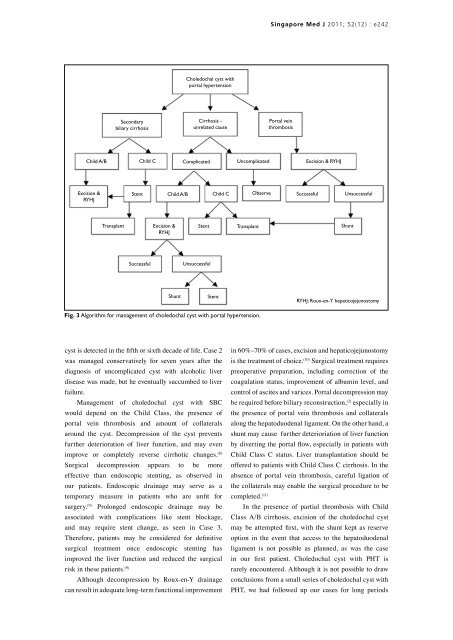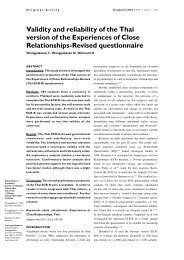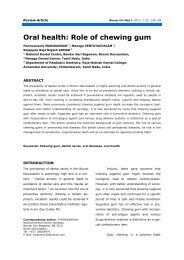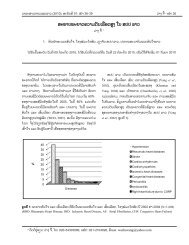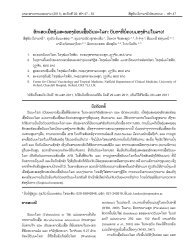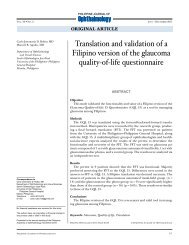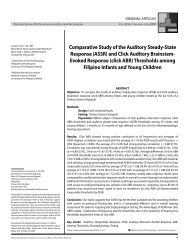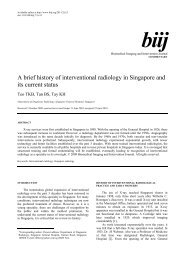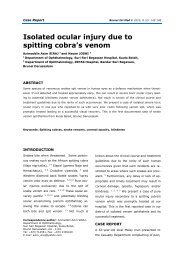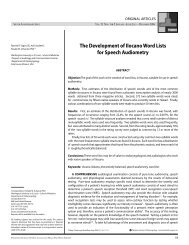Management of choledochal cyst with portal ... - APAMED Central
Management of choledochal cyst with portal ... - APAMED Central
Management of choledochal cyst with portal ... - APAMED Central
You also want an ePaper? Increase the reach of your titles
YUMPU automatically turns print PDFs into web optimized ePapers that Google loves.
Child A/B<br />
Excision &<br />
RYHJ<br />
Secondary<br />
biliary cirrhosis<br />
Stent<br />
Child C<br />
Child A/B<br />
Choledochal <strong>cyst</strong> <strong>with</strong><br />
<strong>portal</strong> hypertension<br />
Child C<br />
Transplant Excision &<br />
RYHJ<br />
Stent<br />
Transplant<br />
Successful<br />
Shunt<br />
Cirrhosis -<br />
unrelated cause<br />
Unsuccessful<br />
Stent<br />
Fig. 3 Algorithm for management <strong>of</strong> <strong>choledochal</strong> <strong>cyst</strong> <strong>with</strong> <strong>portal</strong> hypertension.<br />
<strong>cyst</strong> is detected in the fifth or sixth decade <strong>of</strong> life. Case 2<br />
was managed conservatively for seven years after the<br />
diagnosis <strong>of</strong> uncomplicated <strong>cyst</strong> <strong>with</strong> alcoholic liver<br />
disease was made, but he eventually succumbed to liver<br />
failure.<br />
<strong>Management</strong> <strong>of</strong> <strong>choledochal</strong> <strong>cyst</strong> <strong>with</strong> SBC<br />
would depend on the Child Class, the presence <strong>of</strong><br />
<strong>portal</strong> vein thrombosis and amount <strong>of</strong> collaterals<br />
around the <strong>cyst</strong>. Decompression <strong>of</strong> the <strong>cyst</strong> prevents<br />
further deterioration <strong>of</strong> liver function, and may even<br />
improve or completely reverse cirrhotic changes. (8)<br />
Surgical decompression appears to be more<br />
effective than endoscopic stenting, as observed in<br />
our patients. Endoscopic drainage may serve as a<br />
temporary measure in patients who are unfit for<br />
surgery. (9) Prolonged endoscopic drainage may be<br />
associated <strong>with</strong> complications like stent blockage,<br />
and may require stent change, as seen in Case 3.<br />
Therefore, patients may be considered for definitive<br />
surgical treatment once endoscopic stenting has<br />
improved the liver function and reduced the surgical<br />
risk in these patients. (9)<br />
Although decompression by Roux-en-Y drainage<br />
can result in adequate long-term functional improvement<br />
Observe<br />
Singapore Med J 2011; 52(12) : e242<br />
in 60%–70% <strong>of</strong> cases, excision and hepaticojejunostomy<br />
is the treatment <strong>of</strong> choice. (10) Surgical treatment requires<br />
preoperative preparation, including correction <strong>of</strong> the<br />
coagulation status, improvement <strong>of</strong> albumin level, and<br />
control <strong>of</strong> ascites and varices. Portal decompression may<br />
be required before biliary reconstruction, (2) especially in<br />
the presence <strong>of</strong> <strong>portal</strong> vein thrombosis and collaterals<br />
along the hepatoduodenal ligament. On the other hand, a<br />
shunt may cause further deterioriation <strong>of</strong> liver function<br />
by diverting the <strong>portal</strong> flow, especially in patients <strong>with</strong><br />
Child Class C status. Liver transplantation should be<br />
<strong>of</strong>fered to patients <strong>with</strong> Child Class C cirrhosis. In the<br />
absence <strong>of</strong> <strong>portal</strong> vein thrombosis, careful ligation <strong>of</strong><br />
the collaterals may enable the surgical procedure to be<br />
completed. (11)<br />
Portal vein<br />
thrombosis<br />
Complicated Uncomplicated Excision & RYHJ<br />
Successful<br />
Unsuccessful<br />
Shunt<br />
RYHJ: Roux-en-Y hepaticojejunostomy<br />
In the presence <strong>of</strong> partial thrombosis <strong>with</strong> Child<br />
Class A/B cirrhosis, excision <strong>of</strong> the <strong>choledochal</strong> <strong>cyst</strong><br />
may be attempted first, <strong>with</strong> the shunt kept as reserve<br />
option in the event that access to the hepatoduodenal<br />
ligament is not possible as planned, as was the case<br />
in our first patient. Choledochal <strong>cyst</strong> <strong>with</strong> PHT is<br />
rarely encountered. Although it is not possible to draw<br />
conclusions from a small series <strong>of</strong> <strong>choledochal</strong> <strong>cyst</strong> <strong>with</strong><br />
PHT, we had followed up our cases for long periods


